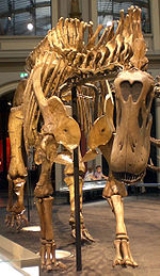
Dicraeosaurus
Encyclopedia
Dicraeosaurus is a genus
of small diplodocoid sauropod dinosaur
. It was named for the spines on the back of the neck. The first fossil was described by paleontologist Werner Janensch
in 1914.
Unlike most diplodocoids, Dicraeosaurus had a large head with a relatively short and wide neck. It also lacked the whiplash tail that other diplodocids had. It was smaller, at only reached 41 feet (12.5 m) in length. It gets its name, which means two-forked lizard, from the spines that came from the vertebrae. They were not straight as in some members of the family. Each one was “Y” shaped, like a fork. These spines also provided muscle attachment points.
Dicraeosaurus lived in the Late Jurassic
. It was herbivorous; however, it didn’t compete with other dinosaurs for vegetation. Fossils have been discovered in the rocks of Tendaguru Hill
in Tanzania
. The rocks also yield fossils of Giraffatitan
and Kentrosaurus
. As there was a distinct difference in size between these animals, they would probably have browsed for vegetation at different levels, allowing them to co-exist without significant competition.
Genus
In biology, a genus is a low-level taxonomic rank used in the biological classification of living and fossil organisms, which is an example of definition by genus and differentia...
of small diplodocoid sauropod dinosaur
Dinosaur
Dinosaurs are a diverse group of animals of the clade and superorder Dinosauria. They were the dominant terrestrial vertebrates for over 160 million years, from the late Triassic period until the end of the Cretaceous , when the Cretaceous–Paleogene extinction event led to the extinction of...
. It was named for the spines on the back of the neck. The first fossil was described by paleontologist Werner Janensch
Werner Janensch
Werner Ernst Martin Janensch was a German paleontologist and geologist.Janensch's most famous contributions stemmed from the expedition he led with Edwin Hennig to the Tendaguru Beds in what is now Tanzania...
in 1914.
Unlike most diplodocoids, Dicraeosaurus had a large head with a relatively short and wide neck. It also lacked the whiplash tail that other diplodocids had. It was smaller, at only reached 41 feet (12.5 m) in length. It gets its name, which means two-forked lizard, from the spines that came from the vertebrae. They were not straight as in some members of the family. Each one was “Y” shaped, like a fork. These spines also provided muscle attachment points.
Dicraeosaurus lived in the Late Jurassic
Jurassic
The Jurassic is a geologic period and system that extends from about Mya to Mya, that is, from the end of the Triassic to the beginning of the Cretaceous. The Jurassic constitutes the middle period of the Mesozoic era, also known as the age of reptiles. The start of the period is marked by...
. It was herbivorous; however, it didn’t compete with other dinosaurs for vegetation. Fossils have been discovered in the rocks of Tendaguru Hill
Tendaguru
The Tendaguru Beds are a fossil-rich formation in Tanzania. It has been considered the richest of Late Jurassic strata in Africa. Continental reconstructions show Tendaguru to have been in the southern hemisphere during the Late Jurassic. Tendaguru is similar to the Morrison Formation except in...
in Tanzania
Tanzania
The United Republic of Tanzania is a country in East Africa bordered by Kenya and Uganda to the north, Rwanda, Burundi, and the Democratic Republic of the Congo to the west, and Zambia, Malawi, and Mozambique to the south. The country's eastern borders lie on the Indian Ocean.Tanzania is a state...
. The rocks also yield fossils of Giraffatitan
Giraffatitan
Giraffatitan, meaning "giraffe titan", is a genus of sauropod dinosaur that lived during the late Jurassic Period . It was originally named as an African species of Brachiosaurus...
and Kentrosaurus
Kentrosaurus
Kentrosaurus is a genus of stegosaurid dinosaur from the Late Jurassic of Tanzania. Its fossils have been found only in the Tendaguru Formation of Tanzania, dated to the Kimmeridgian stage, between about 155.7 ± 4 Ma and 150.8 ± 4 Ma . Apparently, all finds belong to one species, K...
. As there was a distinct difference in size between these animals, they would probably have browsed for vegetation at different levels, allowing them to co-exist without significant competition.

